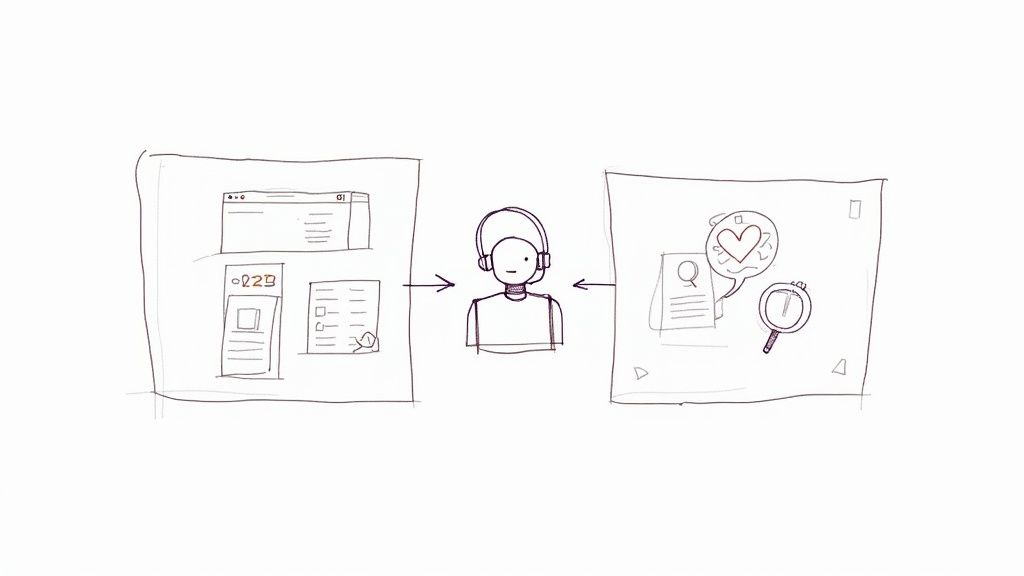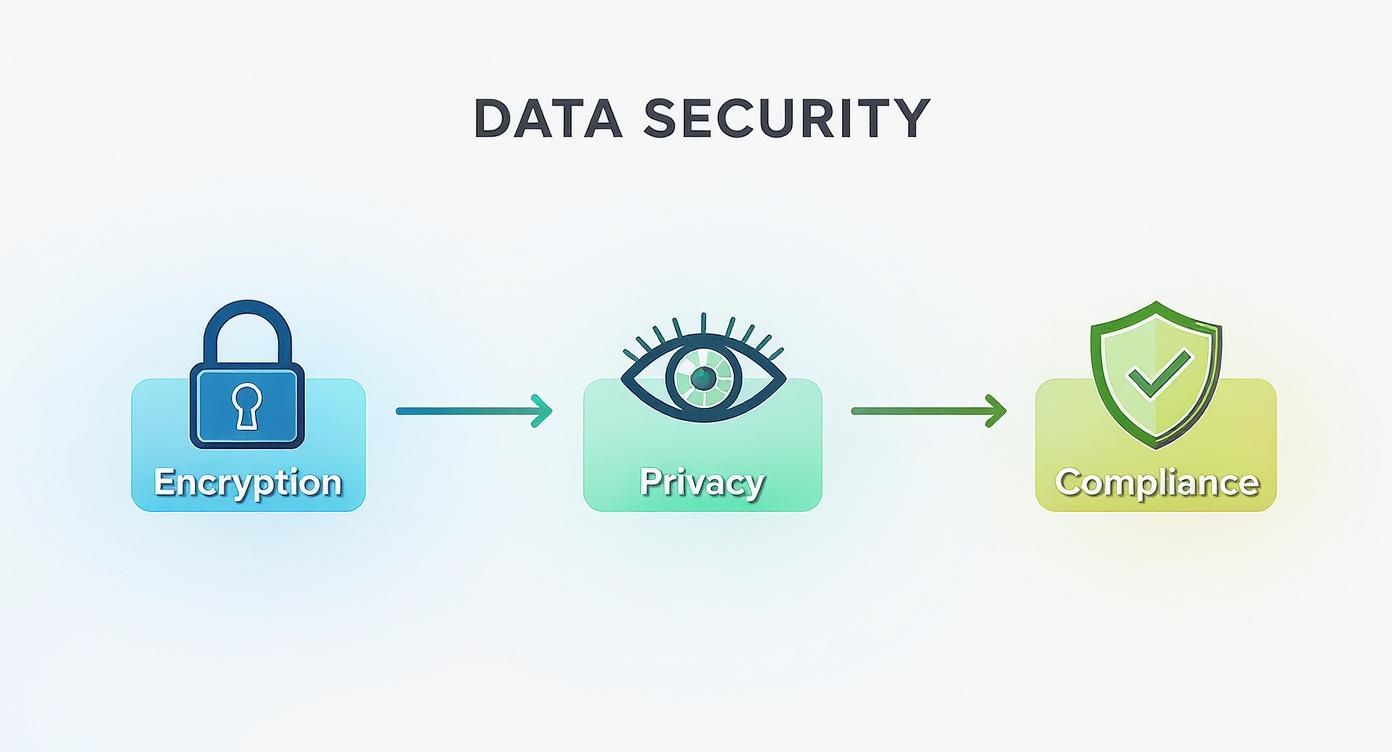AI Chatbots Consulting for Healthcare A Practical Guide
Discover how AI chatbots consulting for healthcare can streamline patient care and boost efficiency. Learn expert strategies for successful implementation.

Healthcare systems are constantly trying to do more with less—improving how they connect with patients while keeping a close eye on the bottom line. This is where AI chatbots consulting for healthcare comes in, offering a strategic partnership to guide medical organizations through the tricky process of choosing, implementing, and managing these conversational tools. It’s about more than just technology; it’s about reshaping how patients access and experience care.
The New Digital Front Door in Modern Healthcare
Let's be clear: AI chatbots today are a world away from the simple Q&A bots of the past. They’ve become sophisticated digital assistants that act as the new "front door" for patient interactions. Think of them not as replacements for your staff, but as powerful force multipliers. They can handle the routine questions, point patients to the right information, and provide support 24/7. This frees up your clinical and administrative teams to focus on the complex, high-touch work that truly requires a human.
This isn't just a niche trend. The global healthcare chatbot market has already sailed past the $1 billion mark, with projections showing it could hit $10 billion within the next decade. This growth is part of a much bigger picture of AI adoption in medicine. A recent survey found that 63% of healthcare professionals are already using AI in some capacity, while another 31% are in the pilot or assessment phase. That's significantly higher than the 50% average across other industries, as highlighted in recent market analyses.

Why Expert Guidance Is Non-Negotiable
Getting this right isn't a simple plug-and-play affair. Healthcare operates under a microscope of regulations like HIPAA, and patient trust is everything. This is precisely why expert consulting is so critical.
A consultant acts as a bridge, translating the intricate needs of a healthcare organization into a viable, secure, and effective technical solution. They ensure the final product isn't just technologically sound but also clinically relevant and fully compliant.
To make sure an AI chatbot project succeeds, a good consulting partner focuses on a few core areas. These pillars form the foundation for a secure, effective, and valuable tool.
Core Focus Areas of AI Chatbot Consulting
Consulting Pillar Objective Key Activities
Strategic Alignment
Ensure the chatbot directly solves a real business problem or improves patient care.
Needs analysis, goal setting, defining success metrics, workflow mapping.
Compliance & Security
Build a secure, trustworthy tool that protects patient data and meets all legal standards.
HIPAA risk assessment, data encryption protocols, secure authentication design.
Technology Selection
Choose the right AI platform and tools for the job, avoiding over- or under-investment.
Vendor evaluation, platform comparison, technical feasibility studies.
Integration & Workflow
Connect the chatbot seamlessly with existing systems like EHRs for a smooth user experience.
API integration planning, data flow design, user acceptance testing.
Ultimately, bringing in a consultant de-risks the entire project. It turns what could be an overwhelming technical challenge into a structured, manageable initiative with a clear path to getting a return on your investment. This kind of strategic guidance is the bedrock of any successful digital initiative.
We dive deeper into this approach in our insights on AI for the healthcare industry, combining foundational AI solutions with the expert oversight needed to turn big ideas into real-world results.
Strategic Use Cases That Deliver Real Value
AI chatbots sound impressive, but what do they actually do to make a difference in a hospital or clinic? Their real power comes to light when you apply them to solve specific, high-impact problems. This isn't about chasing new tech for its own sake; it's about targeting the precise pain points that bog down your organization.
When you boil it down, the most valuable applications fall into two main camps: making your operations run smoother and dramatically improving the patient's experience.
An effective AI strategy engagement is all about figuring out which of these real-world use cases will give you the biggest bang for your buck. It helps you focus your time and resources where the return on investment is highest.

Boosting Operational Efficiency
Let's start with the low-hanging fruit. One of the quickest wins with AI chatbots is automating the repetitive, time-sucking administrative tasks that drain your staff. Handing these jobs over to an AI frees up your skilled team to focus on what they do best: complex, patient-centered work.
Here’s where you’ll see an immediate impact:
- Appointment Scheduling: Imagine a world with fewer phone calls for routine bookings. Chatbots can handle appointment scheduling, cancellations, and rescheduling 24/7, right from your website or patient portal. This cuts down on the frustrating phone tag for everyone involved.
- Billing and Insurance Inquiries: Instead of tying up your administrative lines, a chatbot can instantly answer common questions about billing statements, payment options, and what an insurance plan covers.
- Internal Staff Support: Your own clinical team needs support, too. Chatbots can act as an internal help desk, giving doctors and nurses quick answers on hospital protocols, IT issues, or HR policies. This kind of internal tooling removes daily friction and lets clinicians get back to caring for patients.
These operational gains are foundational. For a broader look at how these tools help, you can explore the typical benefits of chatbots for a business. In healthcare, they help build a more resilient and efficient system from the ground up.
Enhancing the Patient Experience
Beyond making things run better behind the scenes, AI chatbots can completely reshape how patients interact with your organization and manage their own care. The goal is to create a healthcare journey that feels supportive and responsive, not confusing and distant.
By providing instant, personalized support at any time of day, chatbots meet modern patient expectations for convenience and accessibility. They become a reliable first point of contact, building trust and engagement.
Modern hybrid AI chatbots—the ones that mix simple rules with smart machine learning—are already showing incredible results. Studies have shown these systems can reduce hospital readmissions by up to 25%, improve patient engagement by 30%, and cut consultation wait times by 15%.
Here are a few key patient-facing applications that are making a real difference:
- Initial Symptom Triage: A chatbot can guide a patient through a series of questions about their symptoms. Based on the answers, it can help determine the right level of care—suggesting self-care for minor issues, a telehealth visit, or an in-person appointment. It's about getting patients to the right place, faster.
- Medication Reminders and Adherence: Chatbots are perfect for sending proactive reminders to take medications, answering questions about dosages, and even tracking if a patient is sticking to their plan. This is a game-changer for managing chronic conditions.
- Pre- and Post-Operative Guidance: Patients are often full of questions before and after a procedure. A chatbot can provide checklists, answer FAQs about recovery, and send follow-up wellness checks. This simple step can significantly reduce patient anxiety and lead to better outcomes.
These examples show how targeted AI can transform the care experience. For instance, a specialized tool like our https://www.ekipa.ai/products/clinic-ai-assistant is built specifically to handle many of these patient-facing tasks, fitting neatly into a clinic's workflow.
By understanding these strategic use cases, healthcare leaders can start to see a clear path forward. The next step, of course, is making sure all this innovation is built on a secure and compliant foundation.
Navigating Healthcare Compliance and Data Security
In healthcare, nothing is more important than patient trust. It’s the bedrock of the entire system, and that trust is built on the promise of keeping sensitive health information absolutely secure. When you bring an AI chatbot into the mix, that promise doesn't just continue—it becomes a legal and ethical imperative.
Healthcare operates within a maze of regulations that spell out exactly how patient data must be handled. For any hospital or clinic looking at AI, getting this right isn’t optional. It’s the first, most critical hurdle. Overlooking compliance can lead to staggering fines, but even worse, it can shatter the trust you’ve worked so hard to build with your patients. This is why a core part of AI chatbots consulting for healthcare is weaving security into the project's DNA from the very beginning.
The Non-Negotiables of Healthcare Data Protection
Across the globe, two major regulations set the standard for patient data privacy: the Health Insurance Portability and Accountability Act (HIPAA) in the United States and the General Data Protection Regulation (GDPR) in Europe. They come from different places, but they share a common goal: put patients in control of their information and make organizations accountable for protecting it. Any AI chatbot you build has to live and breathe by these rules.
Here are the absolute must-haves:
- Data Encryption: Think of this as a digital lockbox. All Protected Health Information (PHI) must be scrambled and unreadable both while it’s traveling between the patient and the chatbot (in transit) and when it’s sitting in a database (at rest).
- Patient Privacy and Consent: No surprises. Patients must know they’re talking to an AI and explicitly agree to how their data will be used before a single piece of information is shared. Transparency is key.
- Secure Data Storage: The servers and databases holding this information need to be a fortress. That means strict access controls, routine security checks, and constant monitoring to stop breaches before they happen.
- Business Associate Agreements (BAAs): If you bring in an outside partner (like a consultant or vendor), you need a BAA. This is a legally binding contract that makes them just as responsible for protecting patient data as you are. It ensures everyone in the chain is HIPAA-compliant.
Embedding Compliance from the Start
Thinking of compliance as a last-minute item to check off a list is a recipe for failure. A smart consultant helps you sidestep that risk by building security measures directly into the chatbot’s initial design. This proactive mindset is a cornerstone of our AI strategy consulting approach—it’s about architecting a secure system from the ground up, not trying to bolt on security features later.
To properly identify and manage these risks, using specialized HIPAA risk assessment tools is an essential part of the process.
A truly compliant AI chatbot isn't just a piece of software; it's a secure, trusted extension of your clinical environment. The goal is to make security invisible to the patient but rigorously enforced behind the scenes.
This is where deep technical experience really matters. Working with a team that has a background in custom healthcare software development guarantees that every system integration and line of code is held to the highest security standards. This careful, detailed work ensures your chatbot doesn't just pass a legal audit but earns the patient trust required for it to truly succeed.
Your Roadmap to a Successful Chatbot Implementation
Launching a healthcare chatbot without a clear plan is like trying to navigate a hospital without any signs—you'll get lost, waste time, and probably end up frustrated. A structured, phased approach is the only way to turn a complex tech project into a series of manageable, value-driven steps.
This roadmap is at the heart of our AI chatbot consulting for healthcare. It’s designed to make sure every action has a purpose, from the first conversation about what's possible to a full-scale solution that's delivering real results. We break the entire journey down into four distinct phases, building in opportunities to learn and adjust along the way.
Phase 1: Discovery and Strategy
This is where we figure out the "why" before we even touch the "how." The whole point of this first phase is to connect the chatbot project directly to your organization’s biggest clinical or operational headaches. It's a common mistake to rush this part, but a successful chatbot is one that solves a real, specific problem for real people.
The main event here is a deep-dive AI requirements analysis. We'll map out your existing workflows, listen to your teams to find the friction points, and identify the opportunities where automation can deliver the most impact. This isn't just a technical exercise; we bring in stakeholders from clinical, IT, and administrative teams to get a 360-degree view.
The outcome is a Custom AI Strategy report that becomes your blueprint, laying out:
- Defined Goals: Clear, measurable objectives, like reducing appointment no-shows by 15%.
- Target Use Cases: A priority list of tasks the chatbot will handle.
- Success Metrics: The specific KPIs we'll use to measure performance and ROI.
- Technical & Compliance Outline: A preliminary plan for how the chatbot will integrate with your systems and handle data securely.
Phase 2: Design and Development
With a solid strategy in hand, we start bringing the vision to life. This is where the technical build meets human-centered design. We aren't just building a piece of software; we're crafting a conversational experience that patients and staff will actually find helpful and easy to use.
We start by building a prototype or Minimum Viable Product (MVP). This focuses on the core, must-have features we identified in the strategy report. It's a smart way to test the fundamental concept quickly without sinking a huge amount of time and money into a full build right away.
During this phase, our team ensures that all the crucial compliance and security requirements are baked into the chatbot’s DNA from the start—not bolted on as an afterthought.
The infographic below shows how we approach data security. It isn't a final checklist item; it’s a constant, with encryption, privacy, and compliance woven into every step of the development process.

As you can see, these elements work in parallel, creating a fundamentally secure foundation for the chatbot.
Phase 3: Pilot and Refinement
Once the MVP is ready, it's time to see how it performs in the real world. A pilot program with a small, controlled group of patients or staff is the single most important step for fine-tuning the chatbot before a big rollout. This is where theory meets reality.
The goal of a pilot isn't perfection; it's learning. The feedback you get from actual users is gold. It will uncover friction points and opportunities for improvement that no internal team could ever predict.
During the pilot, we focus on:
- Monitoring user conversations to see what's working and what isn't.
- Gathering direct feedback through surveys and interviews with pilot users.
- Tracking performance against the KPIs we defined back in Phase 1.
We use these insights to iterate on the chatbot, polishing its conversational flows, adding to its knowledge base, and squashing any bugs. This user-driven refinement is what turns a good tool into a great one people genuinely want to use. You can learn more about how we manage this iterative cycle in our overview of AI implementation support.
Phase 4: Scale and Optimization
After a successful pilot, you’re ready to go big. This phase involves rolling out the chatbot to a larger patient population or across more departments. But scaling is more than just flipping a switch—it requires a smart change management strategy to get everyone on board.
We help your team develop communication plans, create training materials for staff, and put together promotional content to encourage patients to start using the new tool.
But the launch is really just the beginning. From here, our focus shifts to continuous optimization. We use analytics to monitor the chatbot's performance, identify new opportunities for improvement, and ensure it keeps evolving with your organization's needs. This commitment to ongoing improvement ensures your investment continues to deliver more and more value long after the initial launch.
To make this process even clearer, here’s a summary of the entire journey. This table breaks down what we aim to achieve in each phase and the key activities involved.
AI Chatbot Implementation Roadmap
Phase Primary Goal Key Activities & Deliverables
Phase 1: Discovery
Align the project with key business needs and define success.
Stakeholder workshops, workflow analysis, pain point identification. Deliverable: Custom AI Strategy Report.
Phase 2: Design
Build a functional, secure, and user-friendly MVP.
Prototyping, agile development sprints, user experience (UX) design. Deliverable: Minimum Viable Product (MVP).
Phase 3: Pilot
Test the MVP in a real-world setting and gather user feedback.
Controlled user testing, performance monitoring, feedback collection. Deliverable: Refined and validated chatbot.
Phase 4: Scale
Roll out the chatbot widely and focus on continuous improvement.
Change management, user training, performance analytics, ongoing optimization. Deliverable: Scaled and optimized solution.
Following this phased roadmap takes the guesswork out of implementation. It ensures we're building the right solution to the right problem and sets the stage for long-term success.
Choosing the Right AI Consulting Partner
Picking the right partner for your AI chatbot initiative is one of the most important calls you'll make. A great firm will be your guide, turning your clinical and operational needs into a real-world tech solution that works. The wrong one? You're looking at a blown budget, serious compliance headaches, and a tool that sits on the shelf collecting dust.
This isn't just about technical chops. Any tech vendor can talk about AI, but very few understand the day-to-day realities of patient care, the ironclad rules of HIPAA, or how easily patient trust can be broken. You need a partner who's fluent in both worlds: technology and healthcare. As we explored in our AI adoption guide, the right team is an accelerator, not just a service provider.
Differentiating a Generalist from a Specialist
Think about it this way: you wouldn't hire a general contractor to perform heart surgery. They know how to build things, sure, but they lack the highly specialized skills needed to succeed. The same idea applies here. A specialized healthcare AI consultant has a level of insight a generalist just can't offer.
The ideal partner brings deep healthcare industry knowledge to the table, along with proven expertise in Natural Language Processing (NLP) and machine learning. They don't just build chatbots; they build solutions designed to work within the intricate healthcare ecosystem.
When you're talking to potential partners, look for hard proof of this dual expertise. Their past work should be full of real-world use cases from healthcare, not just examples of retail or banking bots.
Your Vetting Checklist
To help you see past the sales pitch and zero in on what really matters, use this checklist when evaluating consulting firms.
- Healthcare Industry Expertise: Do they have a proven history in healthcare? Ask for specific case studies with hospitals, clinics, or health systems. They should get your challenges immediately, without you having to explain the basics.
- Technical Proficiency: A solid partner must be an expert in the tech that makes these tools work. That means NLP for understanding how patients actually talk, machine learning for making the bot smarter over time, and secure API integrations to connect with your EMR and other core systems.
- Proven Implementation Methodology: Ask them to show you their playbook. Do they follow a clear, structured process, like the phased approach we talked about earlier? A well-defined AI Product Development Workflow takes a lot of the guesswork and risk out of the project.
- Focus on Change Management: The tech is only half the equation. A top-tier consultant will have a plan for getting your staff and patients to actually use the new tool. This includes training, clear communication plans, and a system for listening to and acting on user feedback.
By digging into these areas, you can find a partner who will do more than just build a product. They’ll help guide your organization through the strategic and cultural shifts needed to make the project a genuine success. The our expert team at Ekipa brings exactly this combination of healthcare focus and technical skill, making sure your investment delivers real value from day one.
Measuring Success and Calculating ROI
An AI chatbot sounds great in theory, but it's only a smart investment if you can prove it delivers real results. So, how do you show that your new digital assistant is actually pulling its weight? In healthcare, this isn't just about the bottom line; success is a mix of operational wins and better patient outcomes. A core part of any AI chatbots consulting for healthcare project is figuring out what success looks like from day one and then tracking it obsessively.
The right Key Performance Indicators (KPIs) give you the hard evidence you need to prove the chatbot's impact. These metrics shouldn't be picked out of a hat—they need to connect directly back to the goals you set in your initial strategy. That’s how you ensure you're measuring what actually matters.
Defining Your Key Performance Indicators
Think of your success metrics in two buckets: one for efficiency and cost savings, and the other for patient care and satisfaction.
Operational Metrics:
- Reduced Call Center Volume: What's the percentage drop in calls for routine stuff like scheduling or billing? A 20-30% reduction is a realistic target for many organizations.
- Staff Time Saved: How many hours are your admin and clinical teams getting back now that they aren't answering the same questions over and over? This is time they can pour back into patient care.
- Task Automation Rate: What percentage of questions does the chatbot handle completely on its own, without needing to pass the conversation to a human?
Clinical and Patient-Facing Metrics:
- Patient Satisfaction Scores (CSAT): Don't guess—ask patients directly to rate their experience with the chatbot. This is your fastest way to get honest feedback.
- Appointment Adherence Rates: Are the chatbot's reminders actually reducing your no-show rate? Every avoided no-show is a win.
- Patient Engagement: Look at how often patients are interacting with the chatbot for things like medication reminders, pre-op instructions, or educational content.
Quantifying the Return on Investment
Calculating the ROI is what makes the value of a chatbot impossible to ignore.
Let's run a quick example. Picture a clinic that gets 5,000 calls every month just for appointment scheduling. If each call takes an admin about 5 minutes, a chatbot that automates just 40% of those requests frees up 167 hours of staff time. Every single month. Add in a 10% drop in no-show rates from automated reminders, and you’re looking at serious cost savings and a direct boost to revenue. Our work with internal tooling focuses on building dashboards that track these exact metrics in real-time.
But it’s not all about the numbers. There’s a trust gap we have to acknowledge. Doctors naturally worry about a chatbot’s limitations, and patients aren't exactly lining up for an AI diagnosis just yet. One study revealed that 76% of doctors were concerned about a chatbot’s ability to meet patient needs, while only 10% of patients felt comfortable with a diagnosis from an AI. If you want to dig deeper, you can explore the research on chatbot adoption in healthcare.
This is precisely why tracking the "softer" benefits is so critical. Building patient trust, easing staff burnout, and improving team morale are incredibly valuable outcomes that fuel long-term success, even if they don't fit neatly on a spreadsheet.
Common Questions About AI Chatbots in Healthcare
Whenever you're looking at bringing in new technology, especially in healthcare, a lot of good questions come up. It's only natural. Getting a solid handle on what AI chatbots can—and can't—do is the first real step to feeling confident about moving forward.
Let's walk through some of the most common concerns we hear from healthcare leaders.
How Do Chatbots Provide Safe Medical Information?
This is probably the most important question, and the answer is simple: well-designed healthcare chatbots don't play doctor. They aren’t there to diagnose conditions. Instead, they act as guides, pulling answers from a carefully curated knowledge base that’s been vetted and approved by your own clinical teams. Think of them as a highly reliable navigation tool for patients.
A critical part of any AI chatbots consulting for healthcare engagement is building in smart safety nets. If a chatbot encounters a question that's too complex, sensitive, or hints at a serious issue, it's programmed to immediately and seamlessly hand the conversation over to a real person. No guesswork involved.
Will an AI Chatbot Replace Our Staff?
Not at all. The goal is to support your team, not replace it. The best way to think about a chatbot is as a digital assistant that takes on the high-volume, repetitive tasks that drain your staff's time and energy.
By handling things like routine questions and basic appointment scheduling, chatbots free up your nurses, doctors, and front-desk staff to focus on the hands-on patient care that truly requires their expertise. It lets your team work at the top of their license, where they deliver the most value.
This isn't just about efficiency; it's also a huge boost for morale. When you take the administrative grind off their plates, your people can get back to the work they're passionate about.
What Is a Typical Project Timeline and Cost?
There's no single answer here—it really depends on what you're trying to build. The scope of the project is the biggest factor driving the timeline and budget.
- Simple FAQ Bots: A basic chatbot that just answers frequently asked questions can often be up and running in a pilot phase in just a few weeks.
- Integrated Solutions: If you need something more advanced, like a bot that connects to your EHR to handle personalized scheduling, you're likely looking at a four-to-six-month project.
Costs can be just as varied, ranging from a straightforward monthly fee for an off-the-shelf platform to a larger investment for a solution built from the ground up. The best way to get a clear picture is through an initial AI strategy consulting session, where we can map out your goals and technical needs to give you a precise estimate.
How Can We Encourage Patient Adoption and Trust?
Trust is everything. If patients don't trust the tool, they won't use it. The key is to be completely transparent from the start. Introduce the chatbot as a new convenience tool—a way to get instant answers 24/7—not as a substitute for human care.
Always make it incredibly easy for a patient to opt out and speak to a person. That escape hatch is non-negotiable. It’s also a great idea to run a pilot program first. This lets you gather real-world feedback from a small group of patients, so you can fine-tune the experience before rolling it out to everyone. Be upfront that they're talking to a bot and clearly explain what it can help with.
Ready to transform your patient and staff experience with a secure, compliant AI solution? Ekipa AI provides the expert guidance you need to navigate every step, from strategy to implementation. Let our expert team help you build the right tool for your organization.



